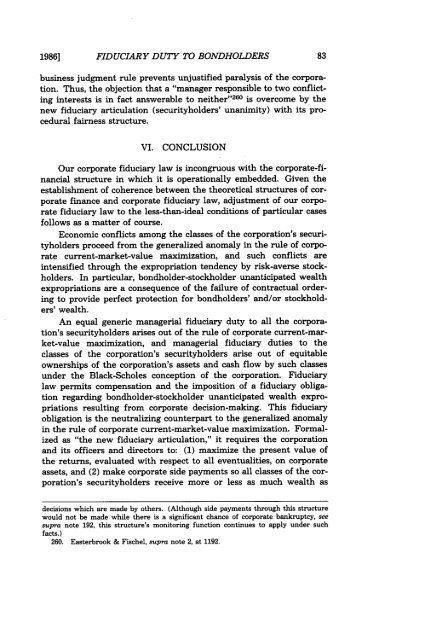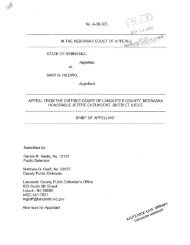Financial Articulation of a Fiduciary Duty to Bondholders with ...
Financial Articulation of a Fiduciary Duty to Bondholders with ...
Financial Articulation of a Fiduciary Duty to Bondholders with ...
You also want an ePaper? Increase the reach of your titles
YUMPU automatically turns print PDFs into web optimized ePapers that Google loves.
19861<br />
FIDUCIARY DUTY TO BONDHOLDERS<br />
business judgment rule prevents unjustified paralysis <strong>of</strong> the corporation.<br />
Thus, the objection that a "manager responsible <strong>to</strong> two conflicting<br />
interests is in fact answerable <strong>to</strong> neither" 260 is overcome by the<br />
new fiduciary articulation (securityholders' unanimity) <strong>with</strong> its procedural<br />
fairness structure.<br />
VI. CONCLUSION<br />
Our corporate fiduciary law is incongruous <strong>with</strong> the corporate-financial<br />
structure in which it is operationally embedded. Given the<br />
establishment <strong>of</strong> coherence between the theoretical structures <strong>of</strong> corporate<br />
finance and corporate fiduciary law, adjustment <strong>of</strong> our corporate<br />
fiduciary law <strong>to</strong> the less-than-ideal conditions <strong>of</strong> particular cases<br />
follows as a matter <strong>of</strong> course.<br />
Economic conflicts among the classes <strong>of</strong> the corporation's securityholders<br />
proceed from the generalized anomaly in the rule <strong>of</strong> corporate<br />
current-market-value maximization, and such conflicts are<br />
intensified through the expropriation tendency by risk-averse s<strong>to</strong>ckholders.<br />
In particular, bondholder-s<strong>to</strong>ckholder unanticipated wealth<br />
expropriations are a consequence <strong>of</strong> the failure <strong>of</strong> contractual ordering<br />
<strong>to</strong> provide perfect protection for bondholders' and/or s<strong>to</strong>ckholders'<br />
wealth.<br />
An equal generic managerial fiduciary duty <strong>to</strong> all the corporation's<br />
securityholders arises out <strong>of</strong> the rule <strong>of</strong> corporate current-market-value<br />
maximization, and managerial fiduciary duties <strong>to</strong> the<br />
classes <strong>of</strong> the corporation's securityholders arise out <strong>of</strong> equitable<br />
ownerships <strong>of</strong> the corporation's assets and cash flow by such classes<br />
under the Black-Scholes conception <strong>of</strong> the corporation. <strong>Fiduciary</strong><br />
law permits compensation and the imposition <strong>of</strong> a fiduciary obligation<br />
regarding bondholder-s<strong>to</strong>ckholder unanticipated wealth expropriations<br />
resulting from corporate decision-making. This fiduciary<br />
obligation is the neutralizing counterpart <strong>to</strong> the generalized anomaly<br />
in the rule <strong>of</strong> corporate current-market-value maximization. Formalized<br />
as "the new fiduciary articulation," it requires the corporation<br />
and its <strong>of</strong>ficers and direc<strong>to</strong>rs <strong>to</strong>: (1) maximize the present value <strong>of</strong><br />
the returns, evaluated <strong>with</strong> respect <strong>to</strong> all eventualities, on corporate<br />
assets, and (2) make corporate side payments so all classes <strong>of</strong> the corporation's<br />
securityholders receive more or less as much wealth as<br />
decisions which are made by others. (Although side payments through this structure<br />
would not be made while there is a significant chance <strong>of</strong> corporate bankruptcy, see<br />
supra note 192, this structure's moni<strong>to</strong>ring function continues <strong>to</strong> apply under such<br />
facts.)<br />
260. Easterbrook & Fischel, supra note 2, at 1192.








